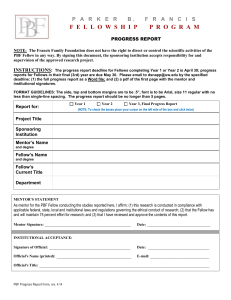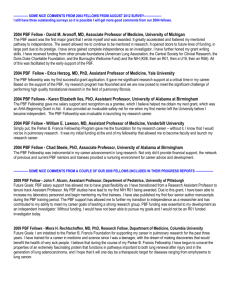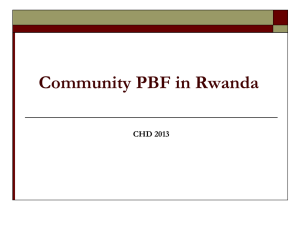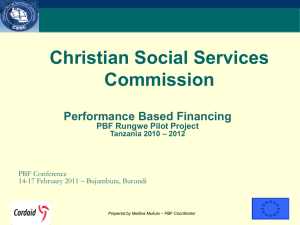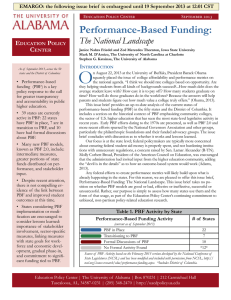PbF Measurement Molecular Spectroscopy
advertisement
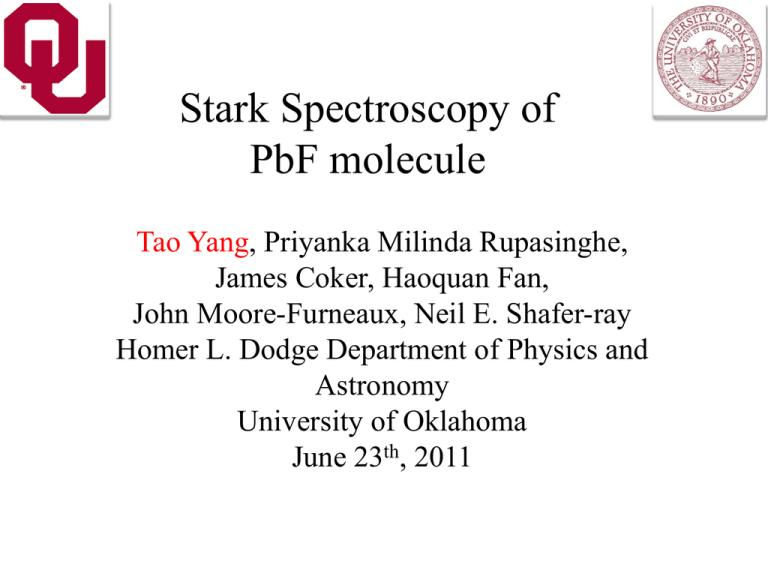
Stark Spectroscopy of
PbF molecule
Tao Yang, Priyanka Milinda Rupasinghe,
James Coker, Haoquan Fan,
John Moore-Furneaux, Neil E. Shafer-ray
Homer L. Dodge Department of Physics and
Astronomy
University of Oklahoma
June 23th, 2011
Table of Contents
History and motivation
PbF as a probe for e-EDM
208Pb19F Stark spectroscopy
Summary
History and motivation
The existence of the permanent e-EDM results in
violations of two fundamental symmetries: ChargeParity Symmetry and Time Reversal Symmetry.
In 2011 Hinds and his coworkers
set a new upper limit with YbF
∗
𝑑𝑒 < 10.5 × 10−28 𝑒 ∗ 𝑐𝑚.
1950
1953
1956
1964
How time flies 2011
Future
* J. J. Hudson, D. M. Kara, I. J. Smallman, B. E. Sauer, M.
R. Tarbutt and E. A. Hinds, Nature 473, 493–496 (2011).
𝑈 = −𝑚 · 𝐵 − 𝑑𝑒 · 𝐸
𝑞
𝑞
𝑚=𝑔
𝑆 , 𝑑𝑒 = 𝑔𝑒𝑑𝑚 (
)𝑆,
2𝑚
2𝑚𝑐
𝜇𝐵= 𝑒ℏ
P
C
T
𝐸
-
-
+
𝐵
+
-
-
𝑆
+
-
-
2𝑚
𝐵 𝐸
−
𝑆
| U T | B | gBo g EDM Eo |
+
T (CP)
𝐵 𝐸
+
−
𝑆
| U T
T
| B | gBo g EDM Eo |
PbF as a probe for e-EDM
We do not measure e-EDM directly, however, we measure
EDM of an atom or a molecule instead.
Eext
1. Larger enhancement factor. Sensitivity to
relativistic, heavy atoms or diatomic
molecules −𝛼𝑑𝑒 · 𝐸.
---P.G.H. Sandars, Phys.Lett (1965)
2. PbF has a large molecular dipole moment
𝑃𝑏 +
𝐹−
Eeff
| U | B | gBo g EDM Eo |
| U | B | gBo g EDM Eeff |
3. PbF has a very small magnetic moment
when it is subjected to a certain electric
field (the g-factor can be tuned near to
zero). 𝜇𝐵 𝑔 ≈ 0.2 Hz/𝜇G.
-- Neil E. Shafer-Ray , Phys. Rev. A 73, 034102 (2006).
𝐸𝑒𝑓𝑓 = 30 𝐺𝑉/𝑐𝑚
In practice, we need only a 8kV/cm to get Eeff= ~30GV/cm
e EDM of the J 1 2 F 1 , M 1 state of PbF
00
mHz 10^ 27 e cm
Eeff (GV/cm)
2
4
6
10
-15
8
10
-3012
0
2
4
6
cm
ElabE kV
(kV/cm)
8
10
Possible problem with PbF as a probe of an e-EDM is
MAGNETIC MOMENT DEPENDS ON THE MAGNITUDE OF E.
g factor of the J 1 2 F 1 , M
1 state of PbF
0.13
0.12
0.11
g
0.10
0.09
0.08
0.07
0
2
4
6
E kV cm
8
10
Optical Alignment of PbF
Optical Probe of PbF
E0
PbF beam
ℰ
𝓔
signal ~ 1 cos 2( g B Bot g EDM B Eot )
To gain sensitivity to the e-EDM,
g B Bot
𝓔
4
208Pb19F
Stark spectroscopy
Pseudocontinuous resonant enhanced multiphoton ionization
(pc-REMPI)
1. Continuous molecular beam source.
2. The beam is crossed with a tunable
diode laser (436nm, 7mW) and
pseudocontinuous laser radiation (6ps pulse width, 76 MHz rep rate, 800
mW, 476 nm).
3. 𝑋1 2Π1/2 𝑣 = 0 ↔ 𝐴 2S1/2 𝑣 = 1
𝐴 2S1/2 𝑣 = 1 ↔ 𝐷 2S1/2 𝑣 = 0 ↔
𝑃𝑏𝐹 + +𝑒 − .
476nm or 468nm
76MHz
6ps
800 mW
multichannel scalar
MCP
PbF+
436nm or 444nm
cw
10MHz
e-
MCP
---P. Sivakumar, C. P. McRaven, P. M. Rupasinghe, T. Yang, N. E. Shafer-Ray, Trevor J. Sears and Gregory E. Hall, Molecular
Physics: An International Journal at the Interface Between Chemistry and Physics, Volume 108, Issue 7 & 9 (2010).
Experimental configuration
Isolator -1436 nm (3%)
HeNe -3-
Diode laser -2- scan trig.
actuator
diod
e
Etalon -5diode
RF
70-90MHz
-4-
436 nm
Digital
Scope
start sync
1kHz
FM
flag
MCS
Start -10Stop
lock electronics
MCP -9-
OPO -6-
864 nm
e-
SFG -8-
532 nm
476 nm
PbF+
MCP -9Nd:YVO4 -7-
1064 nm
Optical Delay
COMPUTER
Spectra of 𝑋1 𝑣 = 0 ↔ 𝐴 𝑣 = 1 band of 208Pb19F
---P. Sivakumar, C. P. McRaven, P. M. Rupasinghe, T. Yang, N. E. Shafer-Ray, Trevor J. Sears and Gregory E. Hall, Molecular
Physics: An International Journal at the Interface Between Chemistry and Physics, Volume 108, Issue 7 & 9 (2010).
Numerical solution for the hyperfine and Stark interaction
eigenvalues of the effective spin-rotational Hamiltonian
H tot H sr H hfs H stark
BJ 2 S ' J I A S ' Dn E '
F ' I ' q ' M ' ' | H sr H hfs | FIqM
p
1
( J )] qq '
2
2
F ( F 1)
] q , q ' }
2F 1
FF ' MM ' '{[ BJ ( J 1) DrotJ 2 ( J 1) 2 q
[
A
4
A/ / A
A A
q ] qq ' [ / /
4(2 F 1)
2
F ' I ' J ' M ' p ' | ( Dnˆ E ') | FIJMp
(1) I F J '
1
( D) II ' p , p ' (2 J 1)(2 J ' 1)(2 F 1)(2 F ' 1)
(
JJ ' )
2
1 J
J
J '
F
F ' I
1
F'
1
F ' M
1
JJ ' )(1)
EM M '
( J ' J
J 1
2J 1
M ' M ' M
F
M
---R. A. Frosch and H. M. Foley , Phys. Rev. 88, 1337–1349 (1952)
---M.G. Kozlov, V.I.Fomichv, Yu Yu Dmitriev, L.N. Labzovsky and A.V. Titov, J. Phys. B: At. Mol. Phys. 20(1987)
---M.G. Kozlov, L.N. Labzowsky, J. Phys. B: At. Mol. Phys. 28(1995)
Simulation of Stark shift on two branches
J
F
p
U
1.5
1.5
1
2
1 37.0431
1 36.8649
2.5
2.5
3
2
1 21.8781
1 21.3115
0.5
0.5
1
0
1 9.26584
1 9.20846
1.5
1.5
2
1
1 0.305133
1 0.36567
0.5
0.5
1
0
1
1
8.93266
10.0018
A
R ff
Pee
2
1.5 1
1.5
1
1
38.396
38.2059
1.5
1.5
1
2
1
1
30.0885
30.006
0.5
0.5
1
0
1
1
15.8211
15.5139
0.5
0.5
0
1
1
1
11.6263
11.5914
X1
1
3
𝑋1 𝐽 = , 𝐹 = 1, 𝑝 = −1 ↔ 𝐴 𝐽 = , 𝐹 = 2, 𝑝 = 1 , 686484 𝐺𝐻𝑧 𝑅𝑓𝑓+
2
2
3
1
𝑋1 𝐽 = , 𝐹 = 2, 𝑝 = −1 ↔ 𝐴 𝐽 = , 𝐹 = 1, 𝑝 = 1 , 686391 𝐺𝐻𝑧 𝑃𝑒𝑒+
2
2
1
2
3
2
2
2
2
DA
DX 1
1
E
U R ff ( ) 0.53
10.35
MHz
2
Debye
Debye
kvolts
/
cm
2
2
2
DA
DX 1
3
E
U [ Pee ( )] 7.67
0.95
MHz
2
Deby
e
Debye
kvolts
/
cm
Pee(3/2)
18
16
14
12
10
8
6
4
2
0
-2.00
Arbitraty units
Arbitrary units
Rff(1/2)
-1.80
-1.60
-1.40
-1.20
-1.00
-0.80
detuning (GHz)
-0.60
-0.40
-0.20
35
30
25
20
15
10
5
0
-2.50
-2.00
0.00
-1.50
-1.00
-0.50
0.00
0.50
1.00
detuning (GHz)
This work(66%
C.L.)
Ref. Y.Y. Dmitriev,
et al, Phys. Lett. A
167, 280(1992)
Ref. K. I. Baklanov,
et al, Phys.Rev.A 82,
060501 (2010)
𝐷𝑋1
3.5 ± 0.3 D
4.62 D
4.26 D
𝐷𝐴,𝑣=1
2.8 ± 0.2 D
——
2.51 D
---Lukas D. Alphei, Jens-Uwe Grabow, A. N. Petrov,
Richard Mawhorter, Benjamin Murphy, Alexander Baum,
Trevor J. Sears, T. Yang, P. M. Rupasinghe, C. P. McRaven
and N. E. Shafer-Ray, Phys. Rev. A 83, 040501(R) (2011).
Simulation of Stark shift on two branches
J
F
p
U
1.5
1.5
1
2
1 37.0431
1 36.8649
2.5
2.5
3
2
1 21.8781
1 21.3115
0.5
0.5
1
0
1 9.26584
1 9.20846
1.5
1.5
2
1
1 0.305133
1 0.36567
0.5
0.5
1
0
1
1
8.93266
10.0018
Ability to do state-selective ionization
In an strong electric field depends
critically on the curvature of these lines!
Qfe(1/2)
A
Qfe(1/2)
R ff
Pee
2
1.5 1
1.5
1
1
38.396
38.2059
1.5
1.5
1
2
1
1
30.0885
30.006
0.5
0.5
1
0
1
1
15.8211
15.5139
0.5
0.5
0
1
1
1
11.6263
11.5914
X1
IT WORKS!!! Expected Spectra of the Q[1/2] Transition in an E Field (95% Uniformity)
E 0.2 kV cm f 674588.GHz
E 4. kV cm f 674588.GHz
6
6
5
5
4
4
3
3
2
2
1
1
0
1.0
0.5
0.0
0.5
1.0
1.5
2.0
0
1.0
E 7.9 kV cm f 674588.GHz
6X
1
0.0
0.5
1.0
1.5
2.0
E 11.6 kV cm f 674588.GHz
( J 1/ 2, e, F 1,| M | 1) A( J 1/ 2, f ,6 F 1,| M | 1)
5
5
X1 ( J 1/ 2, e, F 1,| M 4| 1) A( J 1/ 2, f , F 1, M 0)
4
3
3
X1 ( J 1/ 2, e, F 0) A( J 1/ 2, f , F 1,| M | 1)
2
2
1
1
0
1.0
0.5
0.5
0.0
0.5
1.0
1.5
2.0
0
1.0
0.5
0.0
0.5
1.0
1.5
2.0
Spectra of 𝑋1 𝑣 = 0 ↔ 𝐴 𝑣 = 1 band of 208Pb19F
---P. Sivakumar, C. P. McRaven, P. M. Rupasinghe, T. Yang, N. E. Shafer-Ray, Trevor J. Sears and Gregory E. Hall, Molecular
Physics: An International Journal at the Interface Between Chemistry and Physics, Volume 108, Issue 7 & 9 (2010).
Summary
PbF is a promising candidate for measuring the e-EDM.
We have measured the electric dipole moment of the X1 and A states.
The dipole moments of the X1 and A states allow for an F=1 to F=1
transition that is relatively immune to variations in electric field. This
allows for a magnetic field free measurement of the e-EDM eliminating
many possible sources of systematic error.
E 7.9 kV cm f 674588.GHz
6
5
X1 ( J 1/ 2, e, F 1,| M | 1) A( J 1/ 2, f , F 1,| M | 1)
4
This
work(66%
C.L.)
3
2
Ref. Y.Y.
Dimitiev, et al,
Phys. Lett. A
167, 280(1992)
Ref. K. I.
Baklanov, et
al, Phys.Rev.A
82, 060501
(2010)
4.62 D
4.26 D
1
0
1.0
0.5
0.0
0.5
1.0
1.5
2.0
2.51 D
Lab members
Professors
Neil E. Shafer-ray, John Moore-Furneaux
Graduate students
Priyanka Milinda Rupasinghe, Tao Yang,
James Coker, Haoquan Fan
Undergraduate students
Jacob Stinnett, Jeffery Gillean
Last Generation of graduate students
Poopalasingam Sivakumar, Christopher P. McRaven
Acknowledgements
Supported by the National Science Foundation and the
University of Oklahoma’s Office of the Vice President for
Research.
Thank you!
